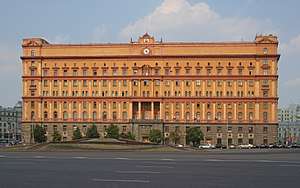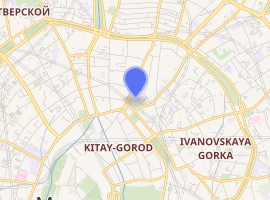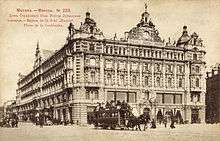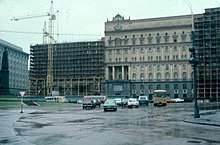Lubyanka Building
Lubyanka (Russian: Лубя́нка, IPA: [lʊˈbʲankə]) is the popular name for the headquarters of the FSB and affiliated prison on Lubyanka Square in Meshchansky District of Moscow, Russia. It is a large Neo-Baroque building with a facade of yellow brick designed by Alexander V. Ivanov in 1897 and augmented by Aleksey Shchusev from 1940 to 1947. It was previously the national headquarters of the KGB; Soviet hammers and sickles can still be seen on the building's façade.
| Lubyanka | |
|---|---|
Лубя́нка | |
 | |

| |
| General information | |
| Architectural style | Neo-Baroque |
| Address | 2 Bolshaya Lubyanka Street |
| Town or city | Moscow |
| Country | Russia |
| Current tenants | FSB |
| Completed | 1898 |
| Client | Rossiya Insurance Company |
| Design and construction | |
| Architect | Alexander V. Ivanov |
History
Origins

Lubyanka was built on the spot where Catherine the Great had once headquartered her secret police.[1]
Lubyanka was originally built in 1898 as the headquarters of the All-Russia Insurance Company (Rossiya Insurance Company),[1] and designed by the architect Alexander V. Ivanov. It is noted for its parquet floors and pale green walls. Belying its massiveness, the edifice avoids an impression of heroic scale: isolated Palladian and Baroque details, such as the minute pediments over the corner bays and the central loggia, are lost in an endlessly repeating palace facade where three bands of cornices emphasize the horizontal lines. A clock is centered in the uppermost band of the facade.
A fountain used to stand in front of the building, at the center of the Lubyanka Square.[2]
Following the Bolshevik Revolution, the structure was seized by the government in 1918 for the headquarters of the secret police, then called the Cheka.[1] The prison became operational in 1920. Its prisoners included Boris Savinkov, Osip Mandelstam, Aleksandr Solzhenitsyn, ...[2] In Soviet Russian jokes, it was referred to as "the tallest building in Moscow", since Siberia (a euphemism for the Gulag labour camp system) could be seen from its basement.[3][4][5] The prison is on the top floor, but since there are no windows on that floor, prisoners always thought they were being detained in a basement.[6]
KGB
During the Great Purge, the offices became increasingly cramped due to staff numbers. In 1940, Aleksey Shchusev was commissioned to enlarge the building. By 1947, his new design had doubled Lubyanka's size[1] horizontally, with the original structure taking up the left half of the facade (as viewed from the street). In addition he added another storey and extended the structure by incorporating backstreet buildings. Shchusev's design accentuated Neo-Renaissance detailing, but only the right part of the facade was constructed under his direction in the 1940s, due to the war and other hindrances.
Raoul Wallenberg was detained in the Lubyanka prison where he reportedly died in 1947.[7] According to the KGB, prisoners interrogations stopped at Lubyanka in 1953 after the death of Stalin.[8]

In 1957, Russia's largest toy shop opened on the opposite side of the Lubyanka Square, where a medieval cannon foundry was previously located.[1] In 1958, the fountain at the center of the Lubyanka Square was replaced by an 11-ton (or 14-ton,[9] or15-ton[10]) statue of Felix Dzerzhinsky ("Iron Felix"), founder of the Cheka.[2]
In 1972, Vasili Mitrokhin moved 300,000 KGB files from the Lubyanka building that he gave to the British intelligence in 1992.[11]
The building's asymmetric facade survived intact until 1983, when the original structure was reconstructed to match the new build, at the urging of Communist Party General Secretary and former KGB Director Yuri Andropov in accordance with Shchusev's plans.
Although the Soviet secret police changed its name many times, its headquarters remained in this building. Secret police chiefs from Lavrenty Beria to Yuri Andropov used the same office on the third floor, which looked down on the statue of Cheka founder Felix Dzerzhinsky. A prison on the ground floor of the building figures prominently in a book written by the author Aleksandr Solzhenitsyn, The Gulag Archipelago. Famous inmates held, tortured and interrogated there include Sidney Reilly, Raoul Wallenberg, Ion Antonescu, Genrikh Yagoda, János Esterházy, Alexander Dolgun, Rochus Misch and Walter Ciszek.
During the 1980s, the prison was turned into a cafeteria for the KGB staff.[8]
Post-KGB
After the dissolution of the KGB in 1991, Lubyanka became the headquarters of the Border Guard Service of Russia, houses the Lubyanka prison, and is one directorate of the Federal Security Service of the Russian Federation (FSB). In addition, a museum of the KGB (now called Историко-демонстрационный зал ФСБ России, Historical Demonstration hall of the Russian FSB) was opened to the public.
In 1990, an employee of the Lubyanka, Katya Mayorova, became Miss KGB, the first official "security services beauty title" delivered worldwide.[12] In 1990, the Solovetsky Stone was erected across from Lubyanka to commemorate the victims of political repression. On 2 August 1991, the statue of Felix Dzerzhinsky was dismantled and removed from the center of the Lubyanka Square.[2][9] That same year, Westerner visitors were allowed for the first time for a tour of the building's prison.[8]
In 2015, the Lubyanka's front door was set on fire by Pyotr Pavlensky, a performance artist.[13] He was released from jail six months later.[14] On 19 December 2019, a shooting took place around the building.[15]
In 2017, a huge church on blood was consecrated next to the Lubyanka building on the grounds of the Sretensky Monastery. The church is dedicated to the New Martyrs and Confessors of the Russian Orthodox Church (including those who were executed at Lubyanka).
Description
The Lubyanka building is home to the Lubyanka prison, the headquarters of the Border Guard Service, a KGB museum, and a subsection of the FSB.[6] Part of the prison was turned into a prison museum, but a special authorization is required for visits.[2]
The lower floors are made of granite with emblazoned Soviet crests.[1]
References
- Richardson, Dan (2001). The Rough Guide to Moscow. Rough Guides. ISBN 978-1-85828-700-3.
- RIR; Romendik, Dmitriy (2014-02-11). "The dark history of Lubyanka". www.rbth.com. Retrieved 2020-08-09.
- Советский политический анекдот [Soviet political anecdotes]. Асс. Спектрум. "О".
- Alef, 495–505, Chamah, 1993
- "1001 избранный советский политический анекдот (1001 selected Soviet political anecdotes)". ModernLib.ru. Retrieved August 22, 2016.
- "Lubyanka – Smoke of the Fatherland". blogs.carleton.edu. Retrieved 2020-08-09.
- "Wallenberg was `shot in Lubyanka' prison". The Irish Times. Retrieved 2020-08-09.
- Imse, Ann (1991-09-07). "Past Echoes in Ex-Soviet Prison : Lubyanka: Old KGB cellblock recalls interrogation and torture of dissidents". Los Angeles Times. Retrieved 2020-08-09.
- Seward, Deborah (22 August 1991). "Statue of Soviet Intelligence Chief Pulled Down". AP NEWS. Retrieved 2020-08-09.
- "The KGB's Old Headquarters Lives On". Cato Institute. 2014-12-11. Retrieved 2020-08-09.
- Persico, Joseph E. (1999-10-31). "Secrets From the Lubyanka". The New York Times. ISSN 0362-4331. Retrieved 2020-08-09.
- Remnick, David (1990-10-31). "Miss KGB Images of the Past". Washington Post. Retrieved 2020-08-09.
- "Russian activist sets FSB door on fire". BBC News. 2015-11-09. Retrieved 2018-01-04.
- Mills, Laura (2016-06-08). "Provocative Russian 'Political Artist' Freed by Moscow Court". Wall Street Journal. ISSN 0099-9660. Retrieved 2020-08-09.
- "Deadly shooting at Moscow security HQ". BBC News. 2019-12-19. Retrieved 2020-08-09.
External links
